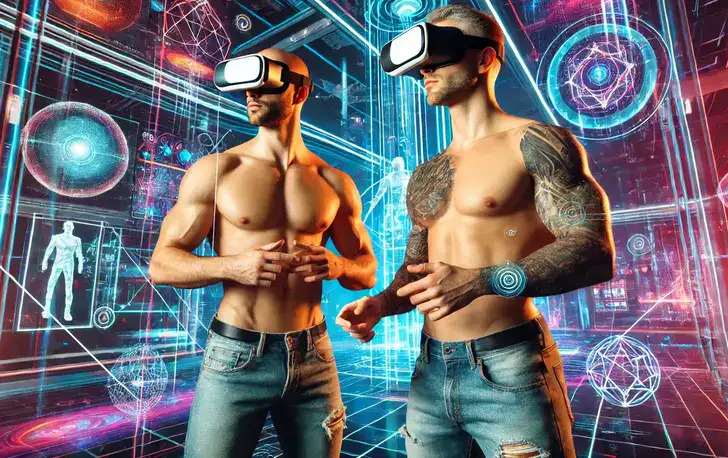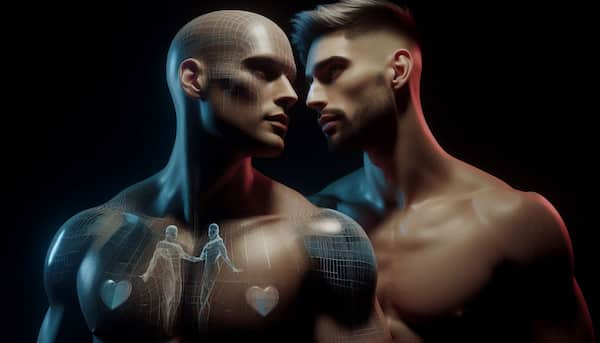The first time I walked into a virtual bar, I wasn’t sure what to expect. My avatar looked polished, my voice modulator was set, and my VR goggles hugged my face snugly. I’d spent hours tweaking my digital representation until it felt like something that reflected, well, me. Or at least the me I wanted to present. It turns out that even in virtual spaces, you’ve still got to think about first impressions.
A lot has been said about how the metaverse is reshaping connection. For gay men, this shift has opened up some fascinating opportunities. Friendships, flirtations, and even love—they all look a bit different when the traditional barriers of geography, appearance, and even physicality disappear. That said, the rules of engagement have shifted too. What works face-to-face doesn’t always translate to VR, and some things we took for granted in real life need a rethink when everything’s filtered through screens and code.
Qu'est-ce que tu penses ?
- How do you feel about the idea of designing a virtual version of yourself? Would you prefer something realistic or imaginative? Answers can reveal how you view self-presentation and influence your comfort in virtual interactions.
- What challenges do you anticipate when forming connections in the metaverse? Your responses could shape how you approach these spaces and interact with others.
The Avatars We Choose and What They Say
Imagine walking into a club where everyone gets to design their body from scratch. In the metaverse, you’re not just deciding what to wear—you’re deciding what version of yourself you want to present. It’s freeing in one sense, but it also adds a layer of complexity. When someone shows up as an eight-foot-tall cyborg or a shimmering specter, you start to wonder how much of that represents who they are versus who they’d like to be.
I’ve noticed that people put a lot of thought into their avatars. Some go for hyper-realistic versions of themselves, complete with carefully rendered freckles and scars. Others lean into the fantastical, creating winged creatures or glowing orbs of light. Every choice feels like a statement.
The decisions often intersect with questions about self-perception, attraction, and identity, especially for gay men. Are you the jock you’ve always wanted to be, or do you lean into your inner theater kid with a flourish of sequins and flair? The freedom is thrilling, but it also sparks some deep self-reflection—even if it’s subconscious.
Summary:
This section examines how avatar choices in the metaverse allow for creative self-expression and influence perceptions of identity and attraction, especially for gay men.
Qu'est-ce que tu penses ?
- What would your ideal avatar look like, and why? Your choice could highlight your personal aspirations or how you wish to be perceived.
- How do you think avatar design affects first impressions? Your thoughts might change how you present yourself in virtual spaces.
Flirting Through Code
In VR spaces, flirting isn’t just about words. Sure, witty banter still goes a long way, but you’ve also got gestures, emotes, and even programmable body language. Sending a wink or a wave is as simple as a button press, but it’s up to you to figure out how to make it feel sincere. It’s a strange mix of the old and the new—part theater, part text message.
The first time I tried flirting in VR, I stumbled hard. A guy’s avatar caught my eye, and I tried to strike up a conversation. My voice modulator glitched, turning my smooth baritone into something that sounded like a helium balloon on its last legs. He laughed, I laughed, and somehow it worked. We ended up chatting for hours, floating together in a zero-gravity lounge. By the end of the night, I’d forgotten about the glitch. The connection felt real, even if the circumstances didn’t.
Summary:
Flirting in the metaverse blends traditional and digital methods, relying on verbal and non-verbal cues like gestures and emotes to create genuine connections.
Qu'est-ce que tu penses ?
- How do you think non-verbal cues impact flirting in virtual spaces? Your perspective could refine how you communicate digitally.
- Have you ever experienced a technical glitch during an interaction? How did you handle it? Sharing experiences might help you prepare for future hiccups.
The Strange Intimacy of Virtual Spaces
One thing I’ve noticed about the metaverse is how quickly people open up. Without the usual barriers—awkward silences, physical insecurities, or the need to find a private corner—conversations can go deep fast. It’s easier to share when you’re not staring someone in the eye, and that distance can create a kind of intimacy that feels oddly pure.
A friend of mine, who’s always been reserved in person, found his voice in VR. He’d show up as a neon fox, cracking jokes and spilling stories he’d never share over drinks in real life. “It’s easier this way,” he told me once. “Nobody’s looking at me, but they’re still listening.” That stuck with me. The metaverse doesn’t erase vulnerability, but it shifts the way we experience it.
Summary:
Virtual spaces can foster rapid and deep intimacy by reducing physical and social barriers, encouraging people to share more openly.
Qu'est-ce que tu penses ?
- Do you find it easier to share personal details online or in person? Your answer might influence how you approach virtual interactions.
- How do you think anonymity affects openness in conversations? Reflecting on this could shape how you interact in digital spaces.
Love and Loneliness in the Metaverse
The metaverse can be a thrilling place for connection, but it’s not without its pitfalls. For every story of romance or friendship, there’s another about disconnection or disappointment. Ghosting takes on a new meaning when someone’s avatar literally disappears mid-conversation, and misunderstandings are amplified when body language is reduced to a limited set of animations.
I’ve had my fair share of virtual heartbreaks. One guy I met seemed perfect. We’d spent weeks exploring VR worlds together, from digital beaches to outer space colonies. Then one day, he vanished. His avatar was gone, his profile inactive. It felt like being stood up on a date, but worse—there was no way to know what had happened. Was it something I said? Did his headset break? Or did he just decide he’d had enough of me? The not knowing was the hardest part.
But for every low, there’s a high. I’ve also made connections that feel deeper than anything I’ve experienced offline. There’s a guy I met in a VR painting class who’s now one of my closest friends. We’ve never met in person, but we’ve spent countless hours talking, laughing, and sharing experiences. It’s not the kind of friendship I expected to find, but it’s one I’ve come to treasure.
Summary:
The metaverse can amplify both the highs and lows of relationships, offering unique opportunities for connection while posing new challenges like ghosting and misunderstandings.
Qu'est-ce que tu penses ?
- Have you ever experienced ghosting in a digital space? How did it affect you? Thinking about this might help you set expectations for virtual relationships.
- What do you value most in an online connection? Your priorities could guide how you approach building relationships in the metaverse.
The Bro Code: Updated for the Meta-Dimension
If there’s one thing I’ve learned, it’s that the unwritten rules of connection still apply, even in the metaverse. Respect matters, as does honesty. Flirting is fun, but only if it’s mutual. And ghosting? Still a jerk move, even when you’re just pixels on a screen.
The metaverse adds a layer of complexity to relationships, but it doesn’t erase the basics. Be kind, be clear, and don’t forget that there’s a real person behind every avatar. Those simple truths haven’t changed, no matter how futuristic the setting gets.
Qu'est-ce que tu penses ?
- What principles do you think are non-negotiable in digital relationships? Your views could strengthen your connections in the metaverse.
- How do you handle conflict or misunderstandings in virtual spaces? Reflecting on this might improve how you navigate tricky interactions.
Closing Thoughts
The metaverse has reshaped how we connect, offering possibilities that feel both thrilling and strange. For gay men, it’s opened up spaces where self-expression and connection take on new forms. But for all the innovation, some things stay constant. A kind word, a genuine laugh, or a moment of shared vulnerability still have the power to bring people together—pixels or not.
So if you’re stepping into this virtual world, take a moment to think about how you’re showing up. Who do you want to be? What do you want to share? The answers might surprise you. They did for me.




